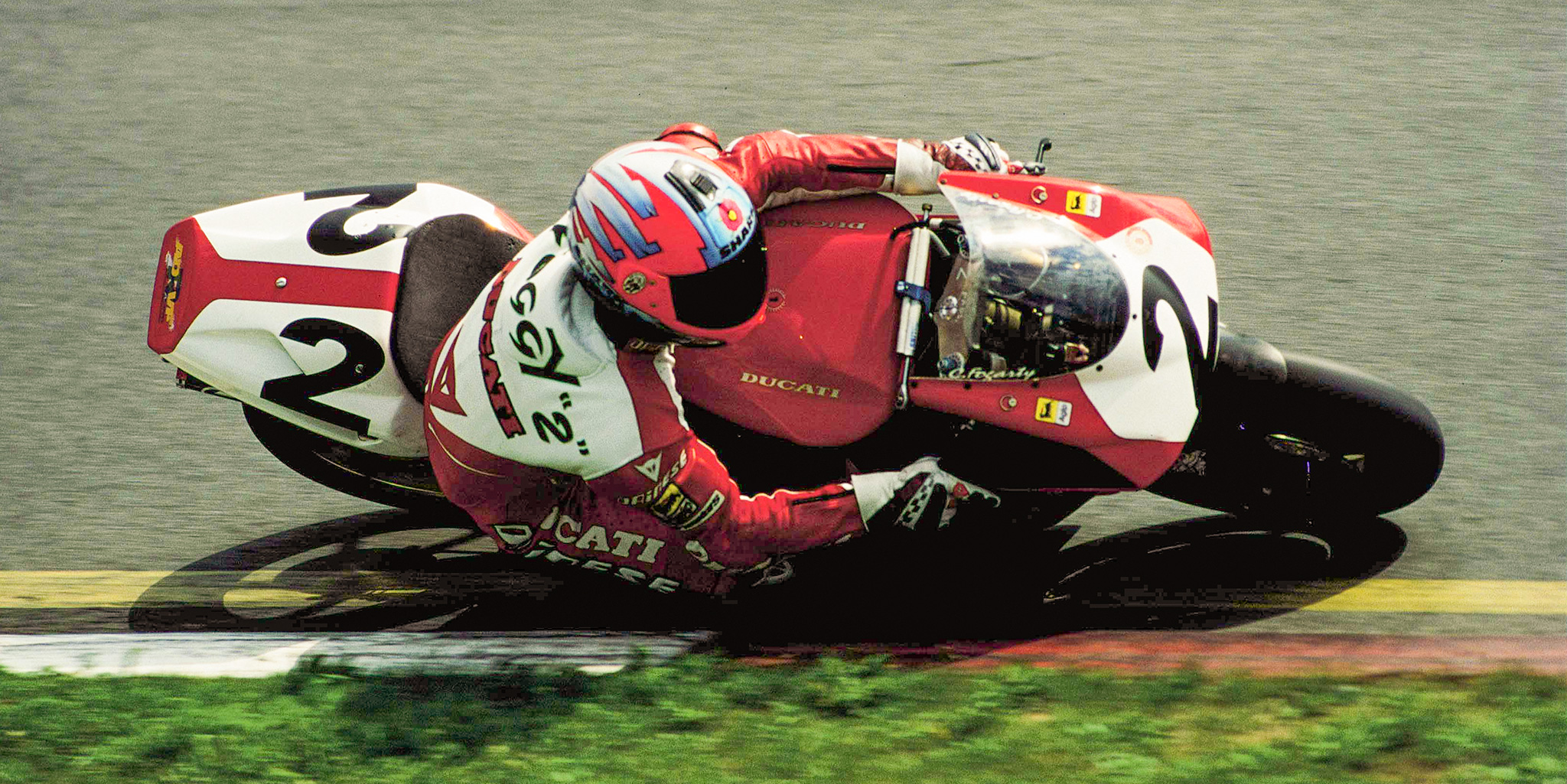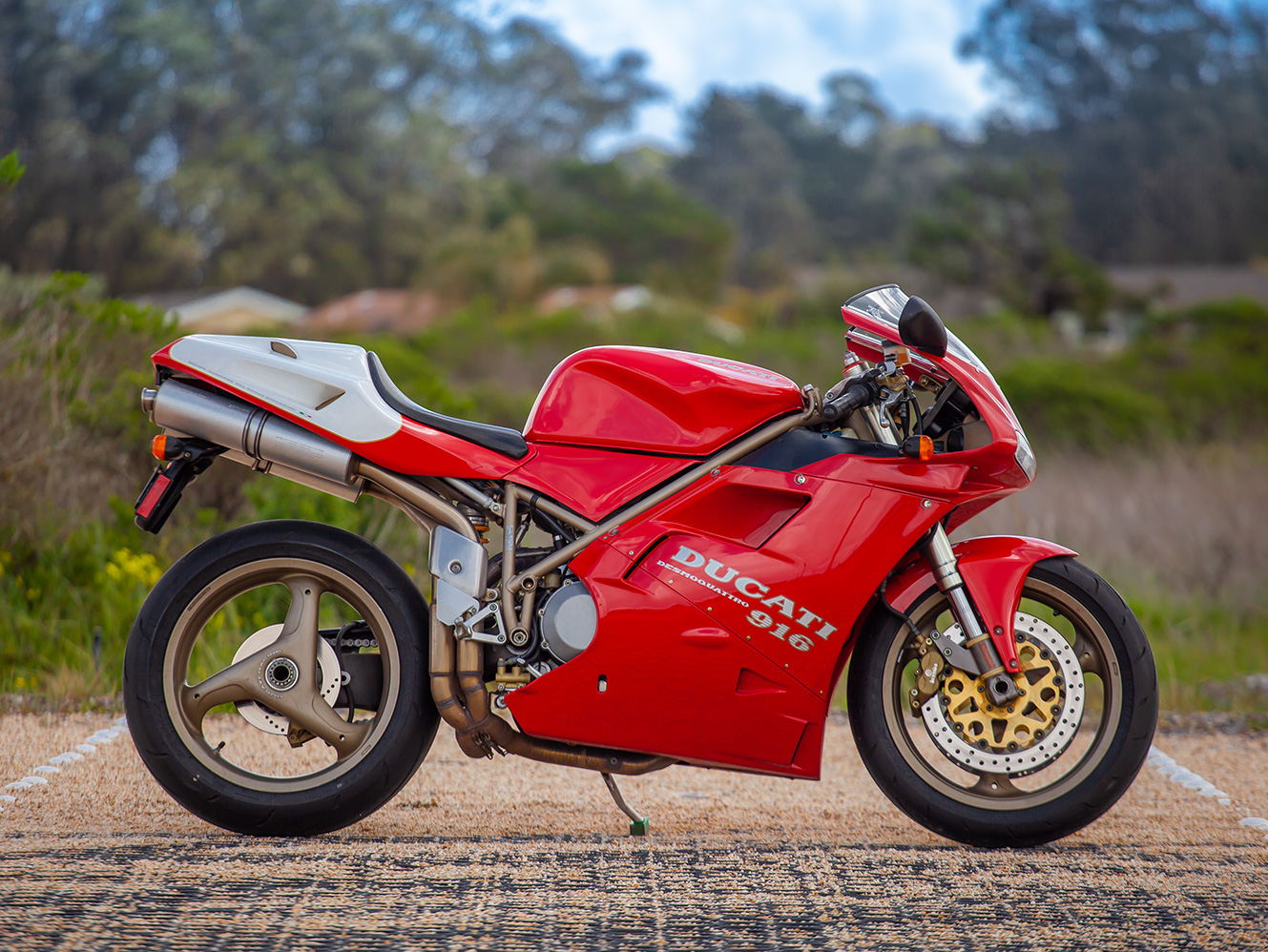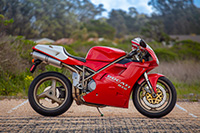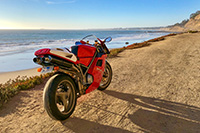
The Ducati 916 is the most beautiful motorcycle made in the last forty years or more. An aggressive stance, clean bodywork and a tail that shows off its rear wheel elegantly combine to make this as timeless as motorcycle design can be. It doesn’t hurt that the engine and chassis made this one of the most successful bikes in racing history. Truly an iconic machine. I was lucky to find this particular 916 in original condition.
Massimo Tamburini and his Masterpiece

Massimo Tamburini has been called the Michelangelo of motorbike design. One can certainly see why when viewing a list of his motorbike designs including the Bimota DB1, the MV Agusta F4 and the MV Agusta Brutale. But it was the Ducati 916 that was Tamburini’s masterstroke.
Massimo Tamburini joined Cagiva in the mid eighties just as Cagiva acquired Ducati. At the time, Ducati was struggling to define itself with aging technology and sagging design credibility. Though Ducati’s 851 and 888 super bikes were successful, the world’s attention had been firmly planted on the Japanese motorcycles winning races. As with any change-the-world event, the creation of the Ducati 916 was combination of smart people and extraordinary luck.
Thanks to Ducati’s “small manufacturer” status in the World Superbike Class, the Italian manufacturer had a different set of rules to adhere to compared to the large Japanese manufacturers. This meant that if Ducati used a twin engine configuration (instead of the race-proven four cylinder designs used by the Japanese), they weren’t restricted to 750cc. Instead, they could enter the race with a twin at up too 1000cc. Ducati’s engineers just happened to have designed a new L-twin engine with four valves per cylinder. The Desmoquattro engine would dominate World Super Bike for more than a decade.
-

![]() The 916's distinct dual headlights.
The 916's distinct dual headlights. -

![]() The Cagiva logo is sprinkled through-out the bike.
The Cagiva logo is sprinkled through-out the bike. -

![]() No nonsense instruments for racing needs only.
No nonsense instruments for racing needs only. -

![]() Fully adjustable Showa forks, Brembo brakes and cast iron disks.
Fully adjustable Showa forks, Brembo brakes and cast iron disks. -

![]() The Desmoquattro engine took WSB by surprise; massive low end torque made the difference!
The Desmoquattro engine took WSB by surprise; massive low end torque made the difference!
Armed with a powerful new engine, Massimo Tamburini and his protege, Sergio Robbiano, designed the lightest motorcycle they could. A steel trellis frame let the engine act as a stressed member. The single-sided swingarm allowed fast wheel changes for endurance racing. The under seat exhaust kept the motorcycle narrow. Finally, fully enclosed bodywork let the machine slip through the air. With each of these design decisions, Tamburini claims that he never focused on appearance. The goal was always to build a light and fast motorbike. Perhaps the motorcycle world’s best example of form following function to great effect.
When the Ducati 916 prototype was unveiled in 1993 it became a sensation: proof that Italian design was alive and well in the motorcycle world. Every motorcycle magazine put the bike on its cover. Celebrities wanted to be photographed with it. But the 916 got perhaps the most attention on the track. The 916 race platform would go on to win the World Superbike Championship in 1994, 1995, 1996 and 1998 including 27 wins from Carl Fogarty and seven wins from Troy Corser.

916 Varese: The Early Bikes
The first 200 bikes were built in 1994 just in time to meet homologation requirements for racing in World Superbike. As 1995 approached, a fire in Ducati’s paint shop forced the production of the early US-bound 916s from the Bologna plant to Cagiva’s Varese factory. Peppered with the Cagiva elephant logo, these Varese 916s were the first taste the public would have of an esthetic and performance revolution in motorcycling.
The truth is that, other than a different letter in the VIN, the Varese bikes from 1995 don’t differ from the 916 bikes made later the same year in Bologna. So why do I care? It’s about history. The bike that I ride is one of very few bikes that were made in the first few months of production. A bike that changed motorcycling forever. How could I not be excited to ride this bike?!
Living with a Legend
What’s it like to ride this bike? One word comes to mind: brutal. As with all bikes intended to be raced, the Ducati 916 is all about speed. Italian design takes this to new heights. Brutal acceleration. Brutal ergonomics. A brutal exhaust note. Everything about this bike says that it is really intended to push the limits of how fast two wheels can take a rider. Comfort was an afterthought.

But the Ducati 916 is not as difficult to live with as you might imagine. It took me only a few minutes to understand why so many people are devoted to these machines. It feels like driving a Ferrari: loud, fast and red. It has an engine who’s growl is unmistakably Italian. Above 60mph the ergonomics start to feel somewhat comfortable. The handling is absolutely superb. Maintenance, though tricky, can be done in your garage to avoid massive bills. Many complain about the infamous Ducati dry clutch rattle. It turns out that this rattle is the result of a badly worn or misconfigured clutch. A quick replacement and setup resulted in a perfectly quiet clutch!









